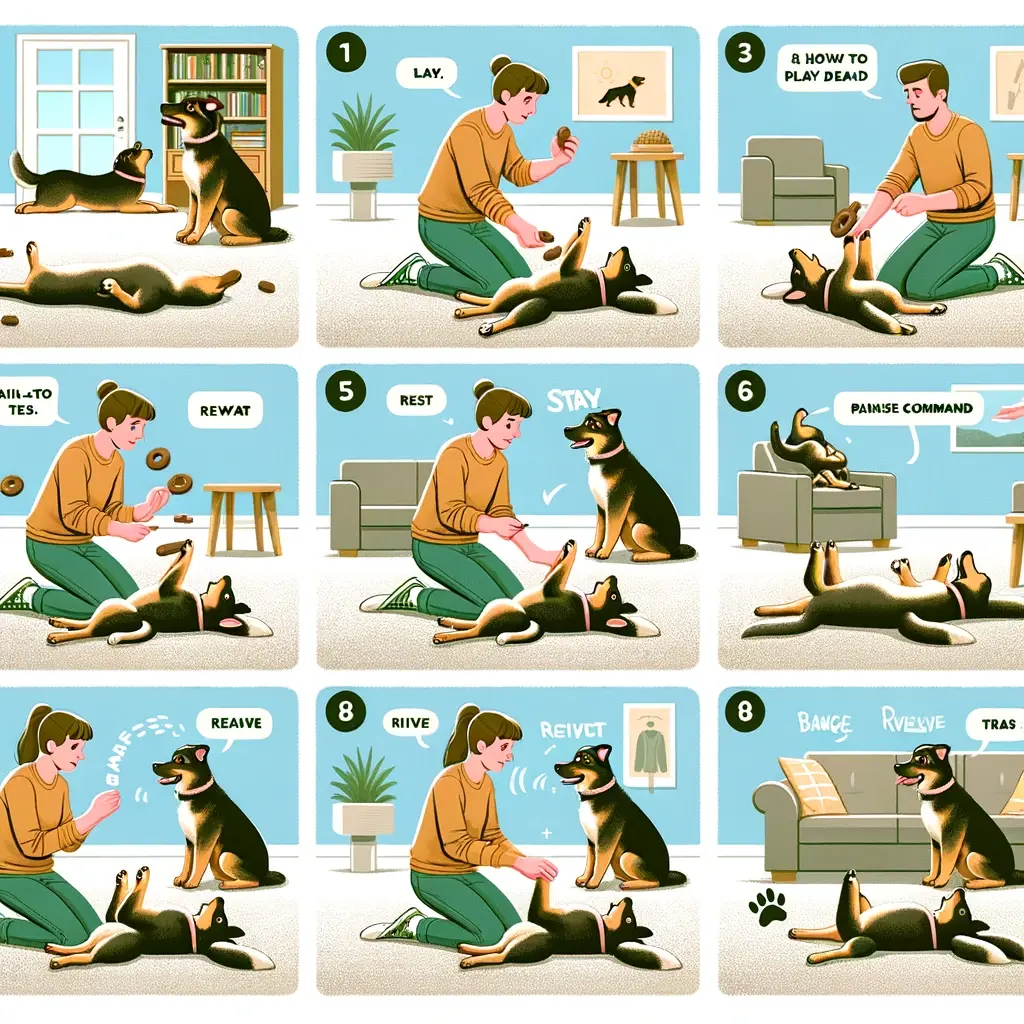Summary
Teaching your dog to “play dead” is a fun trick that strengthens your bond. Start with basic commands like “sit” and “down.” Lure your dog into a lying position, then guide them onto their back with a treat, using a verbal cue like “bang” and a hand signal (finger gun). Reward them for staying still. Gradually increase the duration and practice in different environments. If your dog rolls onto their stomach, break down the steps and reward them for being on their back. Patience and positive reinforcement are key to success!
What is the Need for Verbal Cues?
You might think that training your dog to respond to verbal commands increases training time without providing proportionate benefits, but that needs to be corrected. To familiarise your dog with the desired action, using treats as a reward is acceptable.
But since most of these commands are used in your daily life, you might find yourself in a situation where you must bring your pet under control but do not have a treat.
Also, always rewarding your dog for obeying remote commands is not a great idea, but keep your pet’s health in mind.
What Kind of Verbal Cues Should You Use?
Using the command word associated with the action is an excellent way to make your dog aware of what is expected to be done. Commands like sit, stay, down, roll, etc., are easy to express.
In situations where firmness needs to be displayed, a change in tone to a heavier & stern tone can help your dog recognize the difference in the mood in contrast to the usual, relatively high-pitched voice we generally use with our pets.
While training your dog, use appreciative words like good, yes, etc., in an exclamatory tone. While doing tricks, using related words to dramatize the effect may be a good idea, using words such as bang along with finger motions.
What Should Be Checked Before Teaching Your Dog to Play Dead?
Although it is a relatively harmless trick that doesn’t require the supervision of a professional pet trainer, there are certain things that you, as a responsible pet parent, should look out for before beginning to train your dog.
Check for Immediate Signs of Discomfort
While practicing any part of any trick, looking for any signs of discomfort your pet may be displaying to prevent any possible injury is essential.
Regular Check-Ups with the Vet
Regular check-ups ensure that you are well informed regarding the state of your dog’s health & can immediately trace any health issues & prevent practicing tricks that adversely affect your pet’s health.
Smooth Practice Surface
Ensure that the area you choose for training your pet is free of distractions and any irregularities on the flooring to prevent injuries. Choosing a clean, well-covered surface is ideal to ensure positive outcomes & prevent any mishaps.
How to Teach Your Dog to Play Dead?
Training your dog to play dead is not necessarily the most difficult trick in the book. However, it requires more effort from your end. Simply, playing dead is getting your dog to roll over with its belly exposed in response to a verbal cue or hand signal.
You are breaking down the task into simple steps. This will help your dog grasp the movement faster & to aid this, all you need to do is be patient. Keeping each practice session under 10 minutes will ensure your dog is energized with the training process.
Essentially, playing dead is a dramatized version of rolling over, a trick that can help tone muscles & build stamina.
It also helps in the early detection of any health issues like infections on the stomach or the side of your dog. Your pet should be able to respond to basic commands such as ‘sit,’ ‘stay,’ and ‘down.’
Get Rid of Distractions
An ideal environment for training your dog would be a quiet place with few distractions to ensure maximum focus on the trick.
A soft carpeted floor would help prevent injuries to your pet’s spine. An indoor place would help eliminate any external distractions due to environmental factors or other pets or people.
Make Your Dog Lie Down
Laying down is a way to get your dog to stay put in one spot & is just a step further after teaching your dog to sit down.
Hold a treat before your dog’s nose & move it towards its body & lower it to the floor. Your pet should be sprawled over the floor with its tummy in this position.
Offer a Treat to Get Your Dog to Roll Over
While in the laid down position, use a treat to guide your dog’s movement & move your hand in a semi-circular manner from the front of your pet’s head to the back of its head.
Depending on how your dog is laid on the floor, you should deduce which side would be more accessible to roll over onto. Reward it with the treat once in the desired position on its back.
Command to Stay
The essential part of this trick is to make sure your command is obeyed, and you may have to use a treat to hold your dog in the position for the first few times you practice the trick.
Eventually, just using a verbal command, your dog will get used to staying in the position for a few seconds after rolling over.
Use the Hand Signal or Verbal Command
As you make your dog practice, start using the command action to signify the task after the first few attempts and using verbal cues like banging or shooting or hand signals like your fingers in the shape of a gun motioning the firing of a bullet.
It may take a few attempts for your dog to understand but patiently reward it each time you practice.
Practice in Regular Settings
Once you have trained your dog to act on command, it is time to see whether or not the same can be implemented amid distractions.
Pay close attention to what factors cause the most significant distraction to your dog & slowly explore different outdoor locations where various aspects can be tested.
Add the Revive Command
Taking the trick a step further, after your dog is used to staying in position on its back for a few seconds, use the revive command just when you sense that your dog is getting back up.
Shower your dog with praise & reward it. Practice this multiple times until your dog can identify that it is being awarded for returning to position only after the revive command is given.
Practice the Entire Motion
Now that your dog has learned the simple breakdown of the trick, regular practice is the way to ensure a perfect presentation.
After a couple of tries, get rid of the treat when your dog has learned to perform in response to your signals/ verbal cues. However, reward your dog for a successful performance with heaps of praise.
How to Tackle Problems While Training Your Dog?
Since each dog is unique & has a different ability & pace of learning, you may encounter a few problems while training your dog to play dead. Being patient will make the task easier for you & ensure that your pet learns the trick while you enjoy the training process.
Rolling Over onto its Stomach
If your dog is trained to respond to the roll-over command, you may find it difficult to stop it mid-way to lay on its back.
In such a case, break down the process, gently push your dog to get it to roll over & give it a treat just when it’s on its back. Regular practice will ensure that your dog learns to stop on its back.
Hesitation to Roll
If your dog hesitates to roll onto its side or back, gently nudge it into the required position on its back & immediately reward it with a treat. Your dog should find it easier to lay in the desired position to play dead with a few tries.
Through this article, learning how to teach your dog to play dead can be simplified & made stress-free for you & enjoyable for your pet. And finally, it is rewarding to see your dog successfully behave as per the command and see the fruits of your patience.


